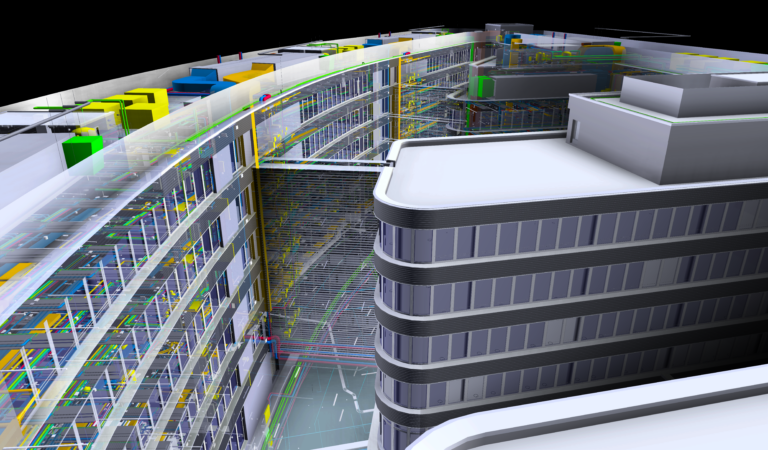BIM-technology
We are constantly trying to make our life easier with technology. In recent times, computer capacity is developing faster and faster. Digitalization is already beginning to encompass a variety of industries and to become common. The Internet makes it much easier to share information. These phenomena further accelerate the process of development and digitalization. The engineering and construction industry is not standing still and at the moment allows to use information technologies to solve its tasks. The main common term for this phenomenon is the abbreviation BIM (or the translation of drawings from 2D to 3D).
What is BIM
Many people say that BIM is a model of a building or a way of developing design and work documentation. These concepts are quite narrowly focused. In essence, BIM has two terms. It can be explained on the one hand as a process, and on the other hand a product.
BIM as a process
If we look at information technology as a process, we can say that:
BIM (Building information modeling) is a process that involves the creation, exchange, and regular use of digital information about a building or part of it throughout the life cycle of an object.
With this process, new areas of work are emerging, and hence new specialists. These specialists form a certain structure, which is called «BIM-Department».
Specialists in this department are very closely connected with IT. There are such, but statistics say that the majority of BIM specialists have a technical and construction education. It is necessary to understand that BIM is a process related to construction, so basically the future BIM specialist needs to initially have competence and experience in this industry. Also, this specialist should go into the IT sphere. For example, to have a basic understanding of what is programming, learns to classify information, work in a certain software.
BIM as a product
So, we have the BIM process, and it is aimed at creating a specific product. The product is the BIM model:
BIM (Building information model) is a model that, in addition to graphical representation, has attribute information in the form of elements and parameters that describe it based on certain requirements of the BIM process. The graphical representation of the model is the responsibility of LOD G (graphical detail level) and the informative LOI (attribute information level).
Consider the gradation of the model representation:
There are 2D models. These are two-dimensional elements, primitives (or their totality). In the CAD system 2D design can be observed the addition of «Custom» attributes, but it has no 3D representation, or it is incomplete.

Image 1 - Two-dimensional representation of the structure - drawing in format . dwg
The 3D model has a 3D graphical representation. But it has almost no attribute information that describes its physical and technical properties. Elements of this model can and will contain basic attributes, but they will only describe its geometry.

Image 2 - Three-dimensional representation of the structure
The BIM model is in turn a collection of elements that have multiple attributes with different data types. These attributes can be interacted with by the user and the creator can provide the necessary information. The content of this information is regulated by the user.

ADVANTAGES OF BIM TECHNOLOGY
Advantages of using BIM for design institutes
1. Тенденция и соответствие государственным требованиям
Mandatory use of BIM on objects of state order since January 1, 2022 has already been legalized. On March 5, 2021, Prime Minister Mikhail Misostin signed the Russian Government Resolution 331 on the introduction of mandatory use of information modeling technologies at state procurement facilities. This was the main reason for many companies to switch to BIM. The trend shows that the use of BIM-technologies allows obtaining an advantage for potential customers. It is in their interest to get the highest quality product.
- Unification of the project development process
Information modeling allows to unify the process of development of project and working documentation. This allows you to build an effective work on the output of the end product, which in turn allows the organization to interact with the elements according to a previously created logic, shifting the work from designers to computer capacity. There is a decrease in the number of internal errors of the organization. Information related to the project is in the model. It is possible to contact it, to interact, to create on its basis functions. It allows to reduce the labor cost of routine operations.
- Standardization of design work.
BIM is a modernization of the design process, creating BIM technology based on your company’s business processes. If this technology will be regulated by internal documents of the company, interaction with new contractors will be carried out at the lowest cost. If desired, the organization can flexibly change the amount of graphic and attributive information for its own needs or requirements of the customer.
2. Автоматизация проектирования
With the built-up process of information modeling there is a possibility of large-scale automation of internal processes of the company. The API of most BIM-complexes is now possible, allowing to develop own plugins and solutions for automation of modeling, calculation and design. If necessary, it is possible to create the necessary automated library-catalogue on the basis of your BIM-process, if necessary, this database can be replenished and used in future projects to speed up the development work. These libraries can be developed on their own, found on the Internet or ask the manufacturer. Information from the information model can be used in the design and working documentation. The information on the graphic part of the project changes automatically as the model changes. This minimizes the time required to work out changes to the project.
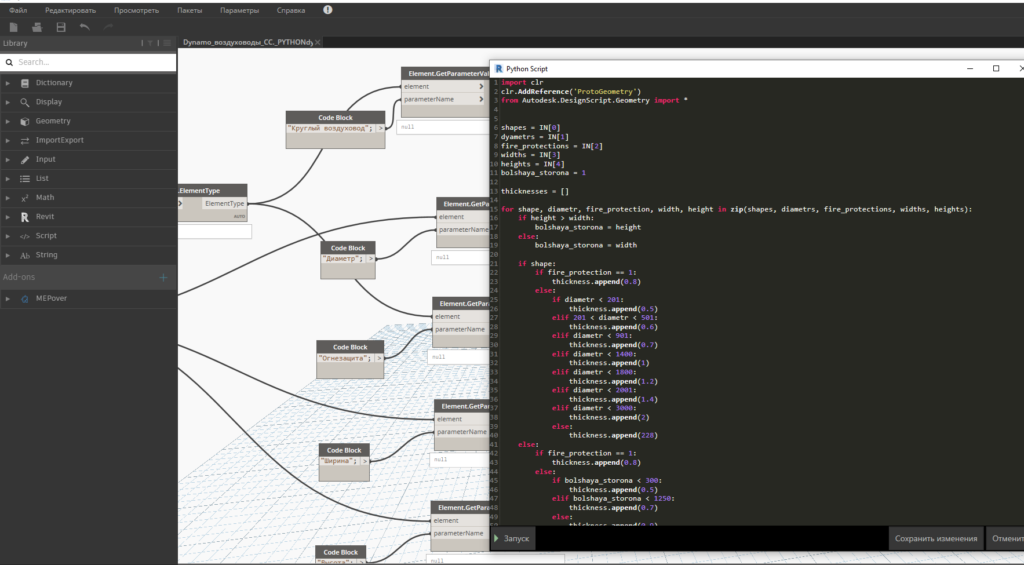
Image 4 - Use of unification of information modelling elements for automation of design work
3. Эффективное использование наработок
Information modeling allows to use previous design solutions and developments as efficiently as possible. Editing and use of engineering units, pre-assembled structures becomes less labor-intensive than in traditional design technologies, which in turn speeds up the project development process.

Image 5 -Using BIM Group Elements for Simulation
4. Повышение качества разработки документации
When using information modeling technology, it becomes possible to more effectively detect project errors, conflicts between sections during development. This avoids costly errors during the design and construction phases. Visualization of the visual part provides more information, which allows you to develop a qualitative project with maximum probability. Interaction with the attribute information of the information model allows to perform complex checks of the future of the project for human errors.
- Effective teamwork
The use of information modeling technology allows you to effectively set up joint work between specialists. By using local or cloud-based ODS (the shared data environment) in the BIM process, you can protect the main project files from technical problems. The ability to track previous versions of the project and synchronize it with the backup reduces the percentage of technical errors and also makes the project development process transparent to the customer. Also an important advantage of BIM will be a single data exchange format. IFC, which allows you to work together even those professionals who work in different software. Format. The IFC allows you to transmit not only graphical but also attribute information. Informative. The IFC models can be adjusted with the help of «mapping» attributes - the process of matching attributes of your model with IFC parameters with the conversion of data types.
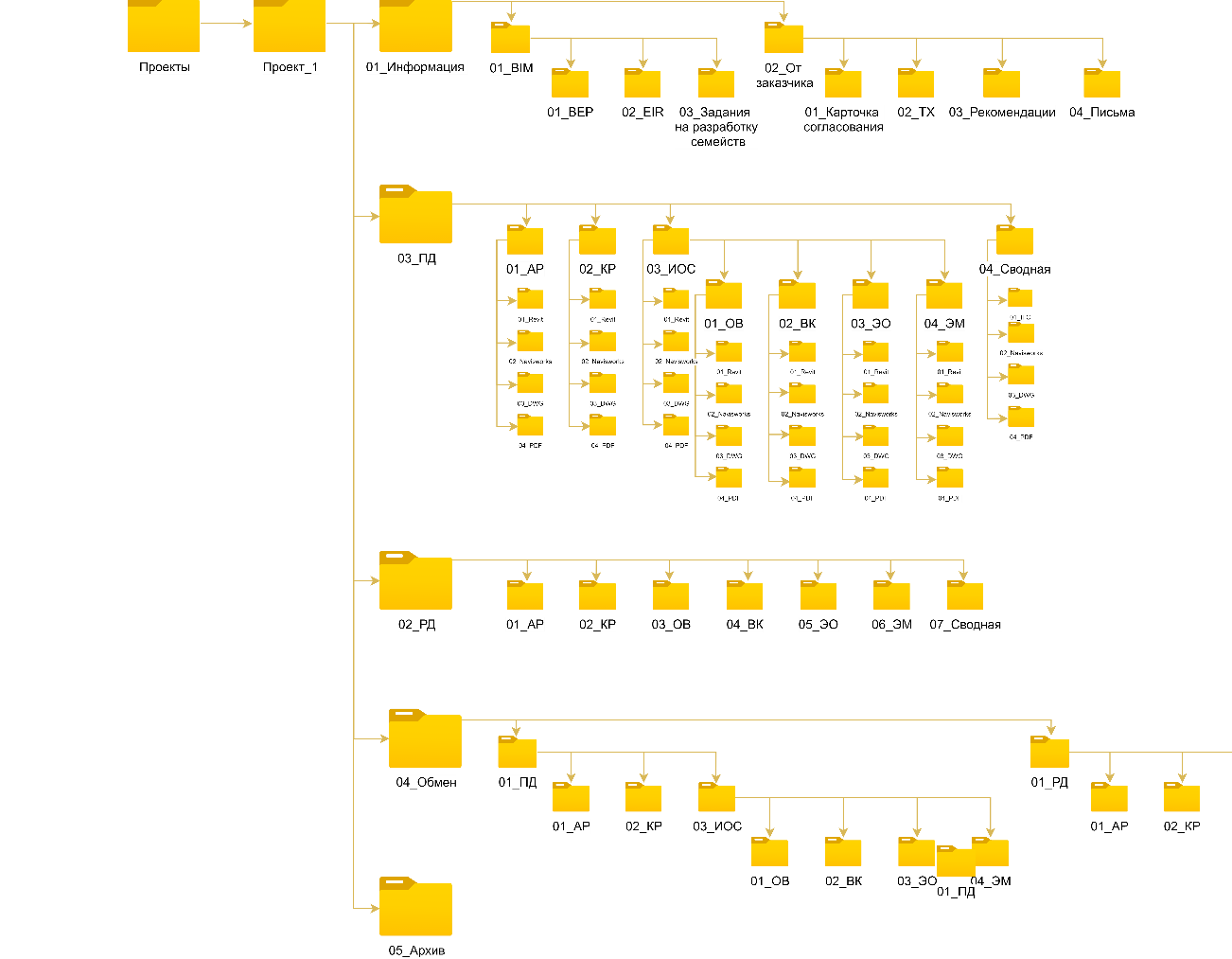
Advantages of using BIM for construction companies
1. Контроль затрат будущего проекта
The technology of information modeling allows to accurately calculate volumes of work. This makes it possible to manage the cost of the facility efficiently and also helps to reduce financial risks associated with inaccurate estimation of the cost of the future structure
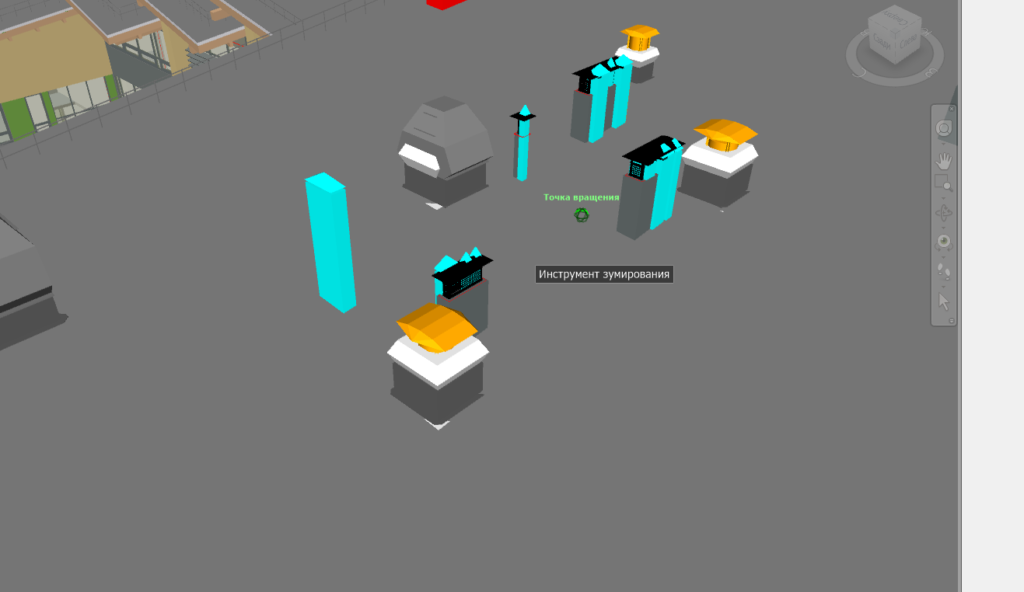
2. Наглядное представление проекта
BIM-model is more obvious for the customer. The general understanding of the future of the facility allows to predict during construction a large number of errors, improves understanding of the design decisions of the project participants. This factor allows the project to be agreed and amended in time at the lowest cost.
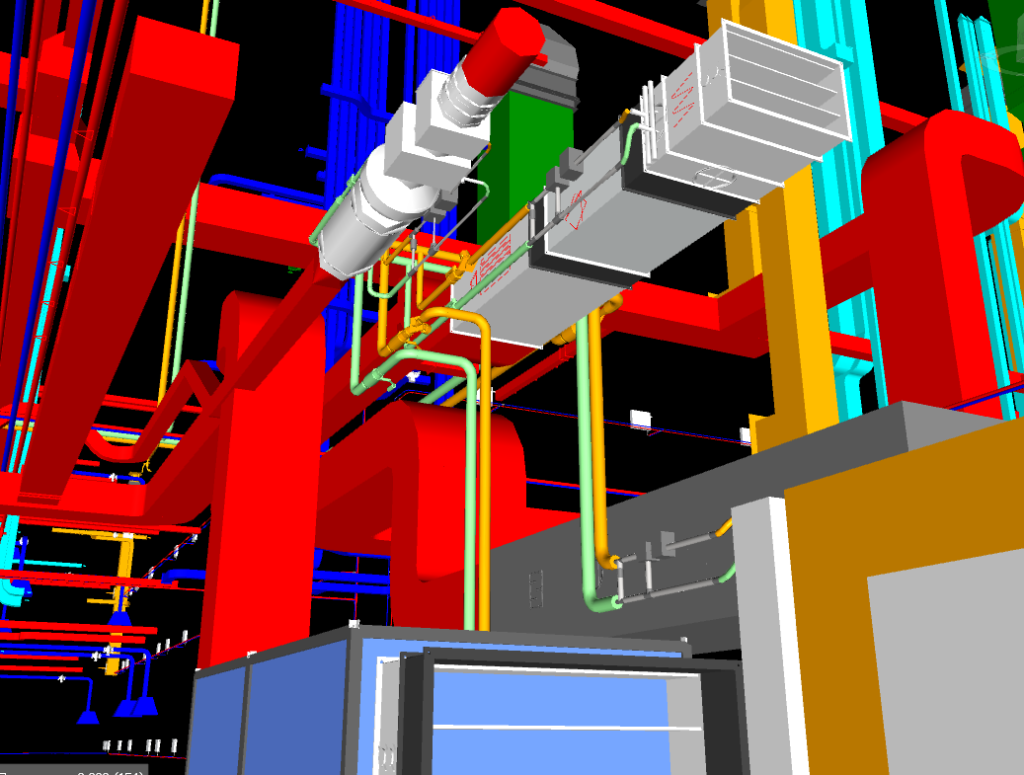
3. Проработка вариантов проектных решений на начальной стадии проектирования
At the stage of consideration of design options, the application of information modeling technology allows to efficiently create and reproduce the assessment of several variants of project execution. This provides an opportunity to compare several variants of volume planning solutions in order to optimize investment costs.
- Effective management and control of the future facility
The use of state-of-the-art solutions that form or upgrade the shared data environment allows effective interaction with all project participants. The information model provided for the construction has all the necessary information. This model can be tested with specialized software.
- Effective site planning
The project customer can use various information modelling tools in 4D to effectively control the quality of the project planning, control the time and the amount of work performed. This implies the use of a BIM model together with a calendar-network graphics. The analysis of the 4D model will help to identify planning errors, visually determine the intersection of resources, calendar and network graphics, get analytical data on the need for materials.

WHAT BIM TECHNOLOGY NEEDS IN YOUR ORGANIZATION
Definition of objectives and prospects
In order to upgrade your business processes, you need to determine the main goals of using this technology. You should explore the software market, get to know the experience of using BIM other companies, learn the basics of this technology to objectively see the internal picture of your company and understand what you need from BIM and whether it will be compatible with businessThe processes of your organization and whether it benefits you.
The purpose of using this technology directly affects BIM-technology. They depend on the purpose of this model and the work process. From the general tasks of using this product information modeling (concept, design, construction, operation), to the specific issues (requirements to attribute and graphical development).
It is important to predict the growth of your organization together with BIM technology. You must understand that BIM can be developed qualitatively. After the introduction of this technology you will sooner or later face that you will have to automate the business processes of your organization and BIM is a powerful foundation for the formation of this.
Time and material resources
The BIM technology is based on material and labor costs. Material costs include the purchase of professional software, training courses, additional computer facilities. An important factor will be that to form a BIM department you need specialists, which are not enough in the market.
The BIM process, as well as its adjustment and future automation, will require considerable time. As a rule - in the initial stage of the company’s formation on the path of BIM there is a loss of speed of work. This is due to the fact that all new technologies are quite complex to accept and their adaptation occurs only over time.
Conclusions
BIM is a digital modernization of the design and construction processes. This technology allows effective interaction with graphical and parametric data and their use not only in design institutes, but also in construction processes. Despite its high cost and complexity, information modelling improves the quality and efficiency of design and construction work through initial material and labour inputs. But as practice shows - BIM later pays for itself. This is the main factor that increases interest in this technology. The current design and construction companies can only understand for what purposes, tasks and prospects they need BIM.
BIM technologies
We are constantly trying to make our lives easier with the help of technology. Recently, computer power has been developing faster and faster. Digitalization is already beginning to cover a variety of industries and come into use. Thanks to the Internet, it becomes much easier to exchange information. These phenomena further accelerate the process of development and digitalization. The design and construction industry does not stand still and at the moment allows you to use information technology to solve your tasks. The main commonly understood term for this phenomenon is the abbreviation BIM (or the translation of drawings from 2D to 3D).
What is BIM
Many people say that BIM is a model of a building or a way to develop design and working documentation. These concepts are quite narrowly focused. At its core, BIM has two terms. It can be explained on the one hand as a process, and on the other hand as a product.
BIM as a process
If we look at information technology as a process, we can say that:
BIM (Building information modeling) is a process that involves the creation, exchange, and regular use of digital information about a building or part of it throughout the entire life cycle of an object.
Along with this process, new areas of work arise, and consequently, new specialists. These specialists form a certain structure, which is called the “BIM Department”.
The specialists in this department are very closely connected with IT. There are some, but statistics say that basically the majority of BIM specialists have a technical and construction education. It should be understood that BIM is a process related to construction, so basically a future BIM specialist needs to initially have competencies and experience in this particular industry. Also, this specialist needs to delve into the IT sphere. For example, to have a basic understanding of what programming is, to learn to classify information, to work in a certain software.
BIM as a product
So, we have a BIM process, and it is aimed at creating a specific product. The product is a BIM model:
BIM (Building information model) is a model that, in addition to a graphical representation, contains attribute information in the form of elements and parameters that describe it based on certain requirements of the BIM process. LOD (the level of graphical detail) is responsible for the graphical representation of the model, and LOI (the level of attribute information) is responsible for the informative representation.
Consider the gradation of the representation of models:
There are 2D models. These are two-dimensional elements, primitives (or their combination). In the CAD system of 2D design, the addition of “Custom” attributes can be observed, but it does not have a three-dimensional representation, or it is incomplete.

Image 1 – is a two-dimensional representation of the structure – a drawing of the format .dwg
A 3D model inherently has a three-dimensional graphical representation. But it has practically no attribute information that describes its physical and technical properties. The elements of this model may contain basic attributes, but they will only describe its geometry.

Image 2 – Three-dimensional representation of the structure
A BIM model, in turn, is a collection of elements that have numerous attributes with different types of data. It is possible for the user to interact with these attributes, and its creator can put the necessary information into these elements. The composition of this information is regulated by the user.

ADVANTAGES OF USING BIM TECHNOLOGY
Advantages of using BIM for design institutes
1. Trend and compliance with state requirements
The mandatory use of BIM at state order facilities from January 1, 2022 has already been legalized. On March 5, 2021, Prime Minister Mikhail Mishustin signed the Decree of the Government of Russia No. 331 on the introduction of mandatory use of information modeling technologies at state order facilities. This has become the main reason for many companies to switch to BIM. The trend shows that the use of BIM technologies allows you to gain an advantage for potential customers. It is in their interests to get the highest-quality product.
- Unification of the project development process
Information modeling makes it possible to unify the process of developing project and working documentation. This allows you to build an effective work on the delivery of the final product, which in turn allows the organization to interact with elements according to a pre-created logic, shifting labor costs from designers to computer power. There is a decrease in the number of internal errors of the organization. The information related to the project is in the model. It is possible to access it, interact with it, create functions based on it. This allows you to reduce labor costs for routine operations.
- Standardization of design work.
BIM represents the modernization of the design process by creating BIM technology based on your company’s business processes. If this technology is regulated by the company’s internal documents, then interaction with new performers, contractors will be carried out with the lowest costs. If desired, the organization can flexibly change the amount of graphic and attribute information to suit its needs or customer requirements.
2. Design automation
When the information modeling process is built up, it becomes possible to automate large-scale internal processes of the company. There is an opportunity for the API of most BIM complexes to develop their own plugins and solutions for automating modeling, calculation and design. If necessary, it is possible to create the necessary automated library-catalog based on your BIM process, as necessary, this database can be replenished and used in future projects to accelerate the development work in the future. These libraries can be developed on their own, found on the Internet or requested from the manufacturer. When making design and working documentation, you can use information from the information model. The information on the graphic part of the project automatically changes along with the model change. This minimizes the labor costs of working out changes in the project.

Image 4 – The use of unification of information modeling elements in order to automate design work
3. Effective use of developments
Information modeling allows you to use previous design solutions and developments as efficiently as possible. Editing and using engineering components, pre-assembled structures becomes a less labor-intensive process than in traditional design technologies, which in turn speeds up the project development process.

Image 5 –Using a group of BIM elements for modeling
4. Improving the quality of documentation development
When using information modeling technology, it becomes possible to more effectively detect design errors, collisions between sections during development. This is what makes it possible to avoid costly mistakes during the development of project documentation and at the construction stage. The visibility of the visual part provides more information, which makes it possible to develop a high-quality project with maximum probability. Interaction with the attribute information of the information model allows you to comprehensively perform certain checks of the future project for human errors.
Effective collaboration
The use of information modeling technology allows you to effectively set up collaboration between specialists. Using a local or cloud-based CDE (common data environment) in the BIM process, you can protect the main project files from technical problems. The ability to track previous versions of the project and synchronize it with a backup copy reduces the percentage of technical errors, and also makes the project development process transparent to the customer. Also an important advantage of BIM will be a single data exchange format .IFC, which allows you to work together even for those specialists who work in different software. Format .IFC allows you to transmit not only graphic, but also attribute information. Informative .The IFC of a model can be adjusted using attribute mapping, the process of matching attributes of your model with IFC parameters with data type conversion.

Advantages of using BIM for construction organizations
1. Cost control of the future project
Information modeling technology makes it possible to accurately calculate the amount of work. This allows you to effectively manage the cost of the facility, and also contribute to reducing the financial risks associated with the inaccuracy of estimating the cost of the future structure.

2. Visual presentation of the project
The BIM model is more visual for the customer. A general understanding of the future of the object allows you to predict a large number of errors during construction, and the understanding of the project participants’ design decisions improves. This factor allows you to coordinate and make changes to the project in time with the lowest costs.

3. Elaboration of design solutions at the initial design stage
At the stage of consideration of design solutions, the use of information modeling technology makes it possible to effectively create and reproduce an assessment of several project execution options. This provides an opportunity to compare several options for space-planning solutions in order to optimize investment costs.
- Effective management and control of the future facility
The use of modern solutions that form or modernize the common data environment allows effective interaction with all project participants. The information model provided for construction has all the necessary information. Verification of this model can be performed using specialized software.
- Effective facility planning
The project customer can use various information modeling tools in 4D for effective quality control of project planning, control of deadlines and completed volumes of work. This implies the use of a BIM model in conjunction with a calendar and network schedule. Analysis of the 4D model will help to identify planning errors, visually establish the intersection of resources, calendar and network schedule, and obtain analytical data on the need for materials.

WHAT IS NEEDED FOR THE FORMATION OF BIM-TECHNOLOGY IN YOUR ORGANIZATION
Defining goals and prospects
To modernize your work processes, it is necessary to determine the main goals of using this technology. You should study the software market, get acquainted with the experience of using BIM from other companies, study the basics of this technology in order to objectively see the internal picture of your company and understand what you need from BIM and whether it will be compatible with your organization’s business processes and whether it is beneficial to you.
The goals of using this technology directly affect BIM technology. The purpose of this model and the workflow itself depends on them. Starting from the general tasks of using this information modeling product (concept, design, construction, operation), ending with specific issues (requirements for attribute and graphic elaboration).
Forecasting the growth of your organization together with BIM technology will be important. You should understand that BIM can be developed qualitatively. After the introduction of this technology, sooner or later you will come across that you will have to automate the business processes of your organization and BIM is a powerful foundation for the formation of this.
Time and material resources
The basis of BIM technology is material and labor costs. The material costs include the purchase of professional software, training courses, additional computer capacity. An important factor will be that in order to form a BIM department, you need specialists who are few in the market.
To build a BIM process, as well as its setup and future automation, significant time costs will be required. As a rule, at the initial stage of the company’s formation on the path of BIM, there is a loss of speed and pace of work. This is due to the fact that all new technologies are quite difficult to perceive and their adaptation occurs only with time.
CONCLUSIONS
BIM is a digital modernization of design and construction processes. This technology allows you to effectively interact with graphical and parametric data and use them not only in design institutes, but also in construction processes. Despite its high cost and complexity, information modeling improves the quality and efficiency of design and construction work at the expense of initial material and labor costs. But as practice shows, BIM pays for itself in the future. This is the main factor that increases interest in this technology. Current design and construction companies can only understand for what purposes, tasks and prospects they need BIM.
[:]






![Подробнее о статье Разработка BIM модели в Bentley[:en]Developing a BIM model in Bentley](https://im-consult.ru/wp-content/uploads/2022/11/2b-768x431.jpg)
